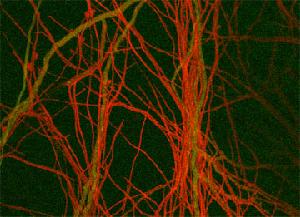
Trichoderma atroviride is a filamentous cosmopolitan fungus, commonly found in soil, and isolated from both tropic as well as temperate climates. It is best known for its biocontrol capabilities against a range of phytopathogenic fungi including Rhizoctonia solani and Botrytis cinerea, which are pests of hundreds of plant crops, including tomatoes, beans, cucumber, strawberries, cotton and grapes. The mechanisms of biocontrol have been studied in two strains of T. atroviride P1, (ATCC 74058) --a fungicide resistant mutant of an isolate from the UK-- and the wild-type isolate IMI 206040, from Sweden. These studies include the formation and characterization of various chitinases, beta-glucanases and proteases, regulation of their transcription and identification of some of the cis- and trans-acting factors; the formation of antibiotics, particularly 6-pentyl-alpha-pyrone and peptaibols; and the involvement of signal transductory cascades (G-proteins and MAP-kinases) in the above processes. In addition, T. atroviride has become a model system for blue-light induced conidiation and gene expression, as well as characterization of the blue light receptors, and the mechanism by which it can solubilize coal (involvement of laccases) has been investigated in some detail.
Genome Reference(s)
Kubicek CP, Herrera-Estrella A, Seidl-Seiboth V, Martinez DA, Druzhinina IS, Thon M, Zeilinger S, Casas-Flores S, Horwitz BA, Mukherjee PK, Mukherjee M, Kredics L, Alcaraz LD, Aerts A, Antal Z, Atanasova L, Cervantes-Badillo MG, Challacombe J, Chertkov O, McCluskey K, Coulpier F, Deshpande N, von Döhren H, Ebbole DJ, Esquivel-Naranjo EU, Fekete E, Flipphi M, Glaser F, Gómez-Rodríguez EY, Gruber S, Han C, Henrissat B, Hermosa R, Hernández-Oñate M, Karaffa L, Kosti I, Le Crom S, Lindquist E, Lucas S, Lübeck M, Lübeck PS, Margeot A, Metz B, Misra M, Nevalainen H, Omann M, Packer N, Perrone G, Uresti-Rivera EE, Salamov A, Schmoll M, Seiboth B, Shapiro H, Sukno S, Tamayo-Ramos JA, Tisch D, Wiest A, Wilkinson HH, Zhang M, Coutinho PM, Kenerley CM, Monte E, Baker SE, Grigoriev IV
Comparative genome sequence analysis underscores mycoparasitism as the ancestral life style of Trichoderma.
Genome Biol. 2011;12(4):R40. doi: 10.1186/gb-2011-12-4-r40
